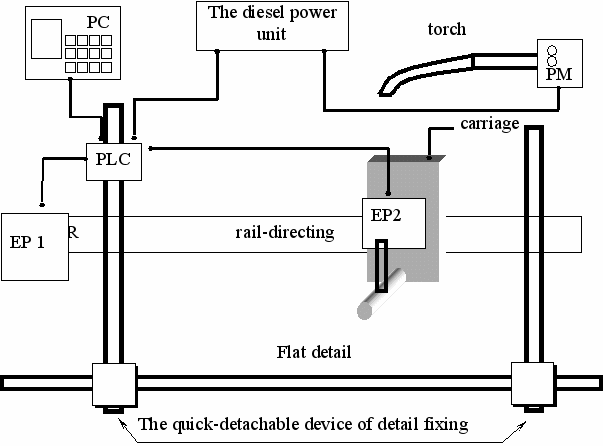Федерации Ассоциация «Агрообразование»
| Вид материала | Документы |
СодержаниеChernysh A.P., Tsurkan A.I. Черныш А.П., Цуркан А.И. |
- Всероссийский круглый стол, 58.29kb.
- И «Ассоциация юристов России» (Ассоциация) зависит, в том числе от разработки и реализации, 137.24kb.
- Министерство здравоохранения и социального развития рф, фгу научный центр акушерства,, 31.82kb.
- Министерство здравоохранения и социального развития рф, фгу научный центр акушерства,, 31.72kb.
- Exhibition Centre «Интерсиб», 149.15kb.
- Нп «сибирская ассоциация консультантов», 77.09kb.
- Нп «сибирская ассоциация консультантов», 62.36kb.
- Пост-релиз Международная специализированная выставка, 338.4kb.
- Iv всероссийский социологический конгресс 2 4 февраля 2012 года, 52.85kb.
- Iv всероссийский социологический конгресс 2 4 февраля 2012 года, 15.95kb.
WORKING OUT OF INFORMATION MODELS OF TECHNOLOGICAL REPAIR BLOCKS FOR RESTORATION OF AGRICULTURAL MACHINE DETAILS WITH THE USE OF SYSTEMATIC APPROACH AT FORMATION OF THEIR STRUCTURE AND PROPERTIES
Chernysh A.P., Tsurkan A.I.
FSEI HPE Kemerovo State Agricultural Institute
РАЗРАБОТКА ИНФОРМАЦИОННЫХ МОДЕЛЕЙ ТЕХНОЛОГИЧЕСКИХ РЕМОНТНЫХ БЛОКОВ ДЛЯ ВОССТАНОВЛЕНИЯ ДЕТАЛЕЙ СЕЛЬСКОХОЗЯЙСТВЕННЫХ МАШИН С ИСПОЛЬЗОВАНИЕМ СИСТЕМНОГО ПОДХОДА ПРИ ФОРМИРОВАНИИ ИХ СТРУКТУРЫ И СВОЙСТВ
Черныш А.П., Цуркан А.И.
ФГОУ ВПО «Кемеровский государственный сельскохозяйственный институт», г. Кемерово
Статья посвящена максимальному сохранению и восстановлению функциональных свойств деталей, подвергающихся различным видам износа, путем систематизации и идентификации показателей качества функциональных поверхностей, создания логики построения информационной модели технологического блока.
Conditions of technological processes of agricultural crop cultivation and variety of agricultural machine designs are defined by conformities of natural laws between influence sets of machines working organs and influence reactions to these processed environments. One of the actual tasks in modern conditions machine operation for cultivation of agricultural production is to preserve and restore the functional properties of the details exposed to various kinds of deterioration.
The decision of this problem consists in preliminary definition, systematization and identification of quality indicators of functional surfaces for concrete service conditions, their interrelations, logic creation of information model construction of the technological block (TB). The technological block is understood as set of methods on processing surfaces, the equipment, technological materials, modes, the metrological maintenance, allowing to provide quality of functional surfaces of machine working organs.
Formation of information model TB provides using of a considerable quantity of the initial data characterizing environment operation systems, constructive-technological tribocharacteristics of module surfaces refusal objects, definition of their interdependence and their character influence on a choice of elements TB.
One of modelling methods and logic creation of technological blocks synthesis is use of neural networks.
The artificial neural network is the device of parallel calculations consisting of a number of co-operating elements – neurals. Each neural periodically receives a signal and sends them to another neurals. All neurals are connected in big network with operated interaction.
At the neural network modelling the bank of experiment results with known entrance arguments and target factors on which the neural network is formed is necessary. Such network gets ability to build communication between arguments and functions of technical system in the form of system model. Thus, to develop neural network model to develop on the basis of the multilayered neural networks, expressing formation process of operational properties of details.
The trained neural network which has successfully passed the test is a ready neural network model adjusted on the decision of a specific target and is a part of integrated system, containing the module of the data preparation; the module of neural network parameters definition; the module carrying out training; the module of testing and the module of neural network allocation.
Data preparation is carried out by means of the inherent tables. The number of the general latent layers does not exceed 10, number of neural in a layer - no more than 100, number of inputs and outputs - no more than 100.
The algorithm of running investigations on neural network model is represented in a following kind:
1. Problem localization, number of inputs and outputs definition;
2. Preparation of investigation results in the form of data tables;
3. Specification of a neural network architecture, a number of the latent layers, a number of neurals in layers;
4. Neural network training;
5. Network testing, error definition at testing;
6. Test on neural network model.
The trained neural network is used for calculation of expected speed of wear process of curvilinear surfaces of friction along their forming.
Test results on neural network model have shown the correlated link between settlement and experimental data that confirms adequacy of model.
The offered technique will allow to systematize repair objects and in addition to identify them on quality indicators (reliability, adaptability to manufacture, application). Such systematization of repair objects will create objective preconditions for a choice and synthesis of technological repair blocks (TRB). One of the examples is the typical scheme TRB based on a blochno-modular principle. In drawing 1 TRB is presented for smelting of flat surfaces of agricultural machine details.
Thus, the offered system concept of restoration objects representation and hardening in the form of surface modules will allow to carry out their system unification, to create element base for technological provision of restoration quality and increase of agricultural machine details resource.

Drawing 1 – Scheme TRB for smelting of flat details: EP 1, EP 2 – servo mechanisms, PLC – the programmed logic controller in a control package; PC – a portable control unit; PM – a semiautomatic device torch.
The literature
1. Kogan, B.I. Methodology of formation of information model of technological repair blocks / B.I. Kogan, A.P. Chernysh // the Bulletin of the Russian Academy of Natural Sciences. 2006. – № 10. – P. 131-137.
2. The Patent. 2333088 RU, MPK С2 В23Р 6/00. A mode of formation of the technological repair block / B.I. Kogan, A.P. Chernysh, (RU). – № 2006129964/02; Заявл. 8/18/2006; Опубл. 27.02.08, Bjul. № 25.
3. Chavdarov, A.V. Modern mechanical welding equipment / A.V.Chavdarov // Innovations. Technologies. Decisions. – 2006, March. – P. 8-9.
4. Chernysh, A.P. Formation of information models of technological repair blocks // Tractors and agricultural machines, 2007. – № 11. – P. 36-39.
УДК 632.937
